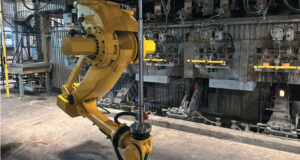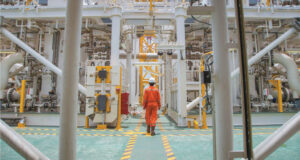
A new state-of-the-art machine is poised to enter the coated recycled board (CRB) market: Graphic Packaging International’s (“GPI”) US$600 million K2 machine being built in Kalamazoo, MI. K2 is designed to be the largest and lowest-cost producer of CRB in North America. It also has an enviable environmental footprint, reducing the amount of greenhouse gases produced across GPI’s CRB platform by almost 20 percent. K2 is a welcome addition to a growing market: it’s been 30 years since the last major investment in CRB, when GPI built its K1 machine, currently operating right next door.
With an expected annual capacity of about 500,000 tons, K2 is an impressive build. At peak construction, about 1,500 contractors swarmed the site under the purview of lead contractor Weiland Construction. The new machine cements Graphic’s position as a world leader in paperboard packaging; it already supplies more than 40 percent of the CRB in the North American market.
The K2 project is so large and ambitious that I couldn’t help wondering—who at the Kalamazoo mill would want to take time out to talk to me about GPI’s safety culture? The answer: everyone.
 GPI’s safety culture extends beyond Kalamazoo facility. Above, the crew at GPI’s Macon, GA, mill poses with the 2020 Award of Excellence—Mills, presented by the Pulp and Paper Safety Association (PPSA). This is PPSA’s most prestigious award given for operating excellence. Three awards are presented annually; the 2020-21 awards looked holistically at each nominee’s safety program, record, and continued efforts to promote safety culture. Nominations for the current year are now open; the award will be presented at the 2022 PPSA Conference. Learn more at www.ppsa.org.
GPI’s safety culture extends beyond Kalamazoo facility. Above, the crew at GPI’s Macon, GA, mill poses with the 2020 Award of Excellence—Mills, presented by the Pulp and Paper Safety Association (PPSA). This is PPSA’s most prestigious award given for operating excellence. Three awards are presented annually; the 2020-21 awards looked holistically at each nominee’s safety program, record, and continued efforts to promote safety culture. Nominations for the current year are now open; the award will be presented at the 2022 PPSA Conference. Learn more at www.ppsa.org.THE INVENTION OF SAFETY
That front-and-center attitude has not always been the case for pulp and paper safety, says Mike Farrell, executive vice president of GPI’s mills division. He’s proud of the evolution that pulp and paper has made during his 32 years in the industry.
“Safety was invented during my career,” Farrell jokes. “When I first started it was nothing to have a person walking on top of a cylinder while another person was pouring a bucket of sulfuric acid on the cylinder to clean it during shutdown. Thank God we don’t do that anymore! Safety has evolved tremendously, and it only keeps getting better.”
An early driver of this evolution was probably the bottom line; unsafe conditions can incur a steep cost, Farrell notes. “But we have come to see that safety is a core value. I personally believe that if you have a good safety culture at a mill, that mill will run well. If you don’t, that mill is never going to perform to its best potential. When you have a robust safety culture, it means you’re doing a lot of things right—and that’s how you get the most out of your operation.”
Like many companies, GPI’s first safety efforts leaned on accountability: rules and consequences. Over time, that culture evolved. “Today, we’re much more about employee engagement,” says Farrell. “We spend a lot of time in our mills teaching our crews about safety—especially how to make a safety intervention. We truly have our best safety record when the employees are watching out for themselves and are willing to approach each other. It is more effective when coming from a peer.”
Weiland’s senior project manager, Doug Waldrop, admires this proactive culture. “Safety is truly first at Graphic Packaging; it has been a good working relationship because they care about safety, and so do we. We don’t just report accidents or near-misses; we learn from them. Our focus is what we can do in the future to prevent it. It’s very action-oriented.”
“New hires on K2 go through a detailed safety orientation, and our investment includes a new training center,” Farrell says. “We knew we would need to train a lot of people who had never made paper before, so we invested a million dollars in developing content that is digital, that people can get on their tablets. We are going to take the digital platform that we developed for K2 to our other mills because that is how people learn now.
“When you tour our mills, you will see that we have very high expectations for housekeeping and making sure our mills are clutter-free, clean, and well-lit. That is table stakes for how to run a paper mill safely,” he says. “Once you do that, the employees see that you care, and that leads to a culture where leaders would rather shut down equipment than be unsafe. But you’ll never get that culture if you can’t keep the lights on.”
CONSISTENCY AND TRAINING
One of GPI’s goals, Farrell says, is consistency. With consistent methods of hazard mitigations and reporting, safety expectations are clear and transparent. “That’s important for operations, and it is important for safety,” he says.
For the K2 project, this extends to the contractors on site every day. “All the engineers involved do walkabouts and audits; they talk about safety all the time,” says Farrell. “If there’s an incident on site, that gets reviewed up to my level (EVP). Weiland has a good safety record and they’ve built the last three Pratt mills, so they’re experienced.”
The communication starts with TAPPISAFE, an industry-recognized safety orientation and verification program that Graphic Packaging requires for every contractor on the K2 build. Jennifer Jackson, GPI’s corporate safety manager mills division, explains.
“TAPPISAFE has been wonderful. It provides a consistent message to all the contractors that come on site. All of our mills use TAPPISAFE. That has helped tremendously with the communication between contractors, which can be extremely hard.”
 The new K2 machine will have a capacity of about 500,000 tpy of coated recycled board (CRB).
The new K2 machine will have a capacity of about 500,000 tpy of coated recycled board (CRB).The TAPPISAFE system makes it easy to monitor and track individual workers, to make sure everyone on site has received the proper orientation—about 5,000 individuals over the course of the project so far. “TAPPISAFE reinforces Graphic Packaging’s values and our own values. It works well; our crews get a good dose of safety,” says Rick Byas, Weiland safety director.
Weiland and GPI also provide additional site-specific orientation and training modules. In addition, GPI participates in weekly contractor meetings to keep the communication flowing.
Farrell adds, “We strive for consistency among mill operations; but that doesn’t mean it’s one-size-fits-all. Jennifer and I work closely to set the tone and direction, then we let each individual mill execute on that. We have mills that are all in different stages of their culture journey, so each needs to figure out how to achieve the goals we’ve established. I can’t mandate engagement; my job is to reinforce safety’s importance to our culture.”
PUTTING THE PRO IN PROFESSIONAL
Communicating successes between facilities is an engine for driving safety. Jackson notes that it starts with a robust hazard mitigation program, driven from the mill floor level. This formalized reporting system empowers employees to recognize hazards. “They know they have the power to say ‘stop—we know a better way to do this job.’ Then the leadership team follows through.”
Another recent success has been Graphic’s PRO Card system. “When I began to look at our injuries, at least 50 percent could have been prevented if we had done a proper pre-job hazard analysis,” says Jackson. “We brought together 20 employees from all of our facilities, including hourly, salaried, and two union presidents to discuss how we could change that. Even the PRO Card name came from the team; it means Prepared, Ready, and Organized.”
The team developed a standardized card that asks what can go wrong, what can be done about it and who will be responsible for the action. Farrell adds, “What amazed me is how eagerly everyone adopted it. Often, a new program gets little traction, but (PRO Cards) absolutely caught fire,” he says. “It’s safe to say that we have done thousands of cards.”
Employees are expected to fill out the card any time they perform a non-routine task. In each mill’s morning meeting, a supervisor will choose a few of that week’s cards for discussion. This solidifies proactive safety as part of the Graphic Packaging culture.
The best part: it works. There has been a measurable drop in incident rates. “More frequently than not, if something went wrong and leadership asks, ‘where’s the PRO Card?’ the response is, ‘we didn’t do one.’ That just reinforces the need,” Farrell says. “It only takes five minutes, but it absolutely gets people in the right mindset.”
BUILDING THE WORKFORCE
From Weiland’s perspective, high safety standards are the only way to do business. “People know that if they come on to a Weiland job, we put safety first; and if we did not have a good safety record, GPI would not even have looked at us. If we can’t attract workers and clients, we can’t make money,” says Waldrop. “If we need 1,500 people on site, we need them to feel safe, or they won’t want to show up.”
Like sustainability, safety can be a powerful tool for attracting and retaining workers, says Farrell, but only if the industry can demonstrate these as core values. “Our industry needs to do more as a whole to spread that message,” he says. “There are opportunities in every industry, but at GPI and a lot of other companies, we consider safety and sustainability at the forefront of who we are.
“If your mills are not safe, if they are not well maintained, you are not going to keep your people,” Farrell says. “We need skilled operators and managers. If we have a lot of turnover, that is going to cost us money, time, and a lot of wasted energy. Safety is essential for getting people in the door—and especially for keeping them. We get better at managing safety when we realize how important it is to our people.”
 Paper 360
Paper 360

